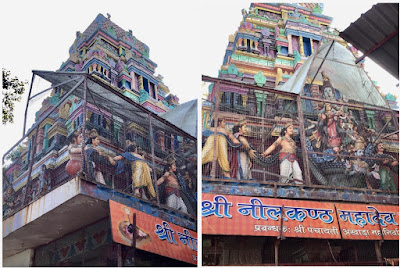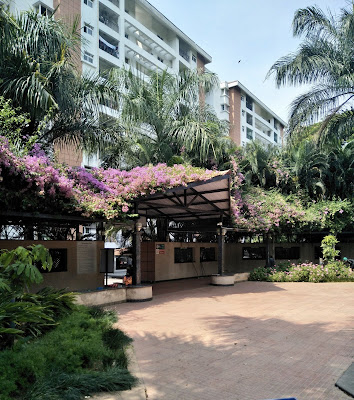An early morning flight to Delhi from Bangalore. Me Wife Son & Daughter-in-law. On reaching airport and completing formalities, gone straight to the Lounge to have breakfast. Hot Crispy Vada Idli Pongal Dosa, just for 2 rupees.
On landing at Delhi, took Metro to New Delhi Station. Lunch at New Delhi station platform. Kaiyendhi Bhawan style. From there, train to Haridwar.
Nagar Ji and Heenu at Haridwar station to receive us. Then an auto to Nagar Ji house. Tasty Nagar Pariwar dinner. Due to hectic journey, straight to bed. Stone cold, 11 degrees.
In the early morning, after having a hot cup of super-taste tea ( made by Madam Nagar Ji ), to the Holi River Ganges for SNANAM. What a crystal clear calm Ganga Ma. Highly blessed to have a holy dip. Prostration to the Sun God. Then performed Abishek to ShivLing and NandiDev with the sacred Ganges water. What a delightful divine blessings.
Me Wife Son to Neelkanth Mahadev Temple by road. An Innova cab arranged for smooth travel. 53 KMs from Haridwar, via Rishikesh. A 12 km stretch, after deviating from NH7 that goes to Badrinath and crossing the Ganges, is surrounded by a dense forest. While driving upon ascending the hill, we can see a quite lot of youngsters doing rafting in Ganges.
The temple is, a sacred pilgrimage place, situated at a height of 1330 meters amidst the valleys of Manikoot, Brahmakoot, and Vishnukoot. It is surrounded by dense forests and sturdy mountain ranges of Nar-Narayan on the confluence of two perennial rivers Pankaja and Madhumati.
This ancient temple is an unmissable not just for the mystical tale that encapsulates it, but also for the lovely sights of the mountains and valleys it showcases and that’s why the trekking way to the temple will be a very thrilling one.
A popular mythological story is that Lord Shiva drank the poison which appeared as a result of the churning of the Ocean . The premise of the temple is touted to be the same place where this incident occurred. When the Lord drank the poison, HIS throat became blue. This is the reason why the temple is also known as ‘Neelkanth” which means ‘Blue Throat’.
The Temple architecture is very colourful and attractive. This splendid architecture stuns the visitors because of the execution of fine detail without the use of technology. The beautiful carvings and intricate architecture is a visual treat that binds me to admire and adore it. The Dravidian style architecture, a Gopuram with three-tiers.
Motifs and Friezes are carved on Gopuram. The eye-catching is the sculptures of various Devas and Asuras depicting the scenes of the mythology story of “Samudra Manthan” (the churning of the Ocean). The inside walls showcase the entire story to honor the sacrifice made by Mahadev for the well-being of the entire World.
The aura surrounding the Shiva Lingam in the sanctum sanctorum is ethereal and subtle. It is widely believed that while Lord Shiva is in deep meditation here, Goddess Parvati came looking for HIM. On HER request, Lord Shiva agreed to return back to Kailash but before leaving HE consecrated the ‘Shivaling’ at the site where HE meditated.
The Pilgrims tie threads around the trunk of a gigantic sacred Peepal tree and pray to get their wishes fulfilled and souls purified. In the temple premises, lies a natural hot spring where devotees take holy bath.
While returning back to Haridwar, visited Lakshman Jhula & Ram Jhula in Rishikesh.
LAKSHMAN JHULA …
It is widely believed that Lord Rama’s brother Lakshman built a bridge with just two jute ropes to cross the river Ganges.
At the very same place where Lord Rama and His brother Lakshman crossed the holy river Ganges, an iron hanging bridge was built which is 450 feet long and suspended at an elevation of 70 feet above the sacred river Ganges. This is one among the iconic landmarks of Rishikesh.
Initially the Lakshman Jhula was made up of jute ropes only and it was a 284 feet hanging bridge but it was completely washed away by the floods in 1924. Then the suspension bridge was built and opened to public in 1929.
( It is understood that the bridge was closed in July 2019 for safety concerns as it was not capable of handling the heavy load of traffic.)
Just opposite to this famous bridge is Tera Manzil Temple which is also known as Trayambakeshwar Temple. Situated on the banks of the sacred river Ganges, it is a 13-storey amazing architecture with a panoramic landscape.
RAM JHULA …
Another suspension bridge across the Ganges. Those days it was an engineering marvel and nowadays it’s one among the most loved tourist attractions because of its amazing architecture and stunning picturesque surroundings. Here Ganga Ma moves calmly with crystal clear view.
Initially it was a bridge made of very strong jute ropes, tightly intertwined to give the strength to hold the weight of people who pass-by. In 1986, it was reconstructed with iron and pillars to provide structural support.
Since it is located nearby the mythological Lakshman Jhula, the name of Lord Ram adorned it.
Late night arrival at Nagar Ji home. Though roads are broad and smooth, continuous journey for more than 12 hours made hectic and tedious. Had a sound sleep though the temperature dropped to single digit.
February 10, 2019.
Heenu Wedding Engagement at Dehradun.
A separate Post on this.
February 11, 2019.
Me Wife Son & Daughter-in-law to Dehradun Airport by cab from Haridwar. On the outskirts of Haridwar, a gigantic Shiv statue.
At Jolly Grant Airport, Dehradun. To Bangalore.
Back home, sweet home.


















This comment has been removed by the author.
ReplyDelete